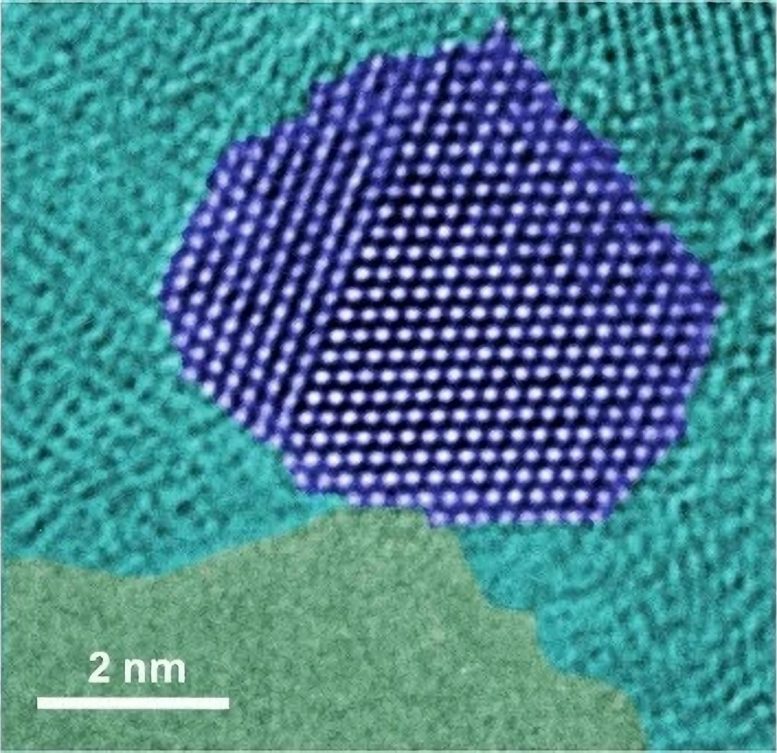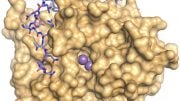
This image, made with a high-resolution transmission electron microscope, shows atoms on the surface of an industrial catalyst used in methanol production. A study by scientists from SLAC, Stanford, and Germany reveals that the catalyst’s copper surface (dark blue) is folded into “steps” and decorated with particles of zinc oxide (turquoise). Credit: Malte Behrens / Fritz Haber Institute of the MPG
Researchers from SLAC and Stanford have teamed with scientists at the Max Planck Institute to examine catalysts in an effort to find an efficient way to make methanol from the carbon dioxide that’s produced by burning fossil fuels, turning a global warming source into a global warming solution.
What’s the best way to make methanol? The question is more pressing than it sounds. Not only is methanol an important industrial chemical – some 50 million tons are used each year to make plastics and other products – but it could also become the basis of a clean energy economy that actually reduces global warming by turning a potent greenhouse gas, carbon dioxide, into fuel.
Now scientists from SLAC and Stanford have teamed with researchers in Germany to figure out a key part of the most common process for making methanol. This new understanding, reported last week in Science, is an important step toward improving the process and eventually realizing the goal of capturing carbon dioxide released by the burning of fossil fuels and turning it into something you can put in your gas tank.
The key ingredient is a catalyst – a substance that promotes chemical reactions without being consumed itself. Back in the 1960s, chemists tweaked particles of copper, zinc oxide, and aluminum oxide into a sponge-like catalyst that is highly efficient at making methanol from syngas. This recipe has been used ever since, but why it worked was never completely understood.
“In order to know how it works, we need to know what the active site looks like” – the surface of the catalyst where chemicals are brought together and persuaded to react, said Felix Studt, a theoretical chemist at SLAC’s SUNCAT Center for Interface Science and Catalysis. “The problem with a lot of other studies is that they were on surfaces that were very far away from being a real catalyst, under real working conditions.”
He and two other SUNCAT theorists – Frank Abild-Pedersen and institute Director Jens K. Nørskov – have been studying theoretical models of methanol synthesis. They had identified the two most important factors in making a good catalyst: the presence of defects in the material and the presence of zinc or another oxygen-loving metal.
At the same time, researchers in Berlin found experimental evidence that the best catalysts had exactly those features. The groups teamed up to draw the first comprehensive picture of the catalyst’s active site.
Studying the actual industrial catalyst in all its complexity proved quite a challenge, said chemist Malte Behrens, leader of a research group at the Fritz Haber Institute of the Max Planck Society in Berlin that collaborated on the study. “But our feeling was that it was necessary to do that,” he said, “because all these little details, impurities and defects, in the end, turned out to be relevant.”
With scientists at Süd-Chemie AG, an important industrial producer of catalysts, the Berlin group made and tested five versions of the methanol catalyst. All were composed of the same chemical elements, but they varied slightly in the details of their preparation. This turned out to make a huge difference, Behrens said; the one made according to the traditional recipe worked very well, while others worked poorly or not at all.
Then the researchers in Germany examined these samples in several ways: with an electron microscope, by neutron scattering and with an X-ray beam at BESSY II, a synchrotron light source at the Helmholtz-Zentrum Berlin for Materials and Energy. The X-ray studies were carried out in the presence of gases that are used to make methanol, and under conditions similar to those in the industrial process.
The result: the first experimental evidence that reflects the full complexity of the active part of the industrial catalyst. It revealed that the copper surface was folded into “steps” and decorated with particles of zinc oxide, and that this configuration was stabilized by other defects in the material.
“There are so many other things, such as copper particle size and oxidation state, that might have mattered or not,” Behrens said. “The theory helped us understand that these are really the necessary ingredients. In the end, the picture that developed from these results is comprehensive, because theory and experiments confirm each other.”
With this information in hand, the researchers are in a position to further tweak the recipe and perhaps find an efficient way to make methanol from the carbon dioxide that’s produced by burning fossil fuels, turning a global warming source into a global warming solution.
Importantly, methanol could be blended into fuel and distributed at existing gas pumps, with no need to build an entirely new fueling infrastructure.
For SUNCAT, the work on methanol is just a beginning, Studt said. “The hope is that we can do this not only for this catalyst, but for other catalysts,” he said. “If you understand how it works, then you have a much different approach to optimizing it than through trial and error.”
Reference: “The Active Site of Methanol Synthesis over Cu/ZnO/Al2O3 Industrial Catalysts” by Malte Behrens, Felix Studt, Igor Kasatkin, Stefanie Kühl, Michael Hävecker, Frank Abild-Pedersen, Stefan Zander, Frank Girgsdies, Patrick Kurr, Benjamin-Louis Kniep, Michael Tovar, Richard W. Fischer, Jens K. Nørskov and Robert Schlögl, 19 April 2012, Science.
DOI: 10.1126/science.1219831









Be the first to comment on "Searching for an Efficient Way to Make Methanol"